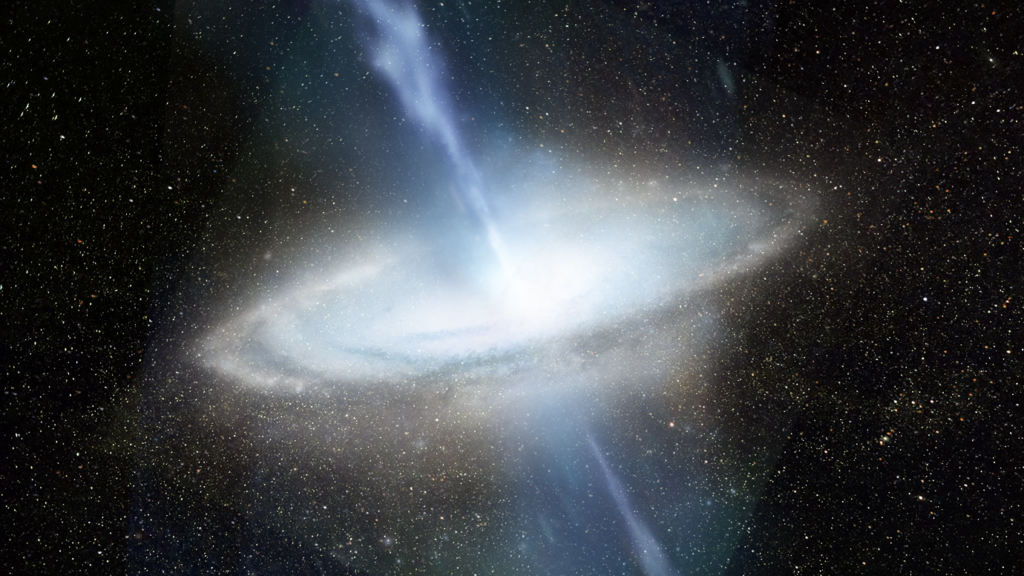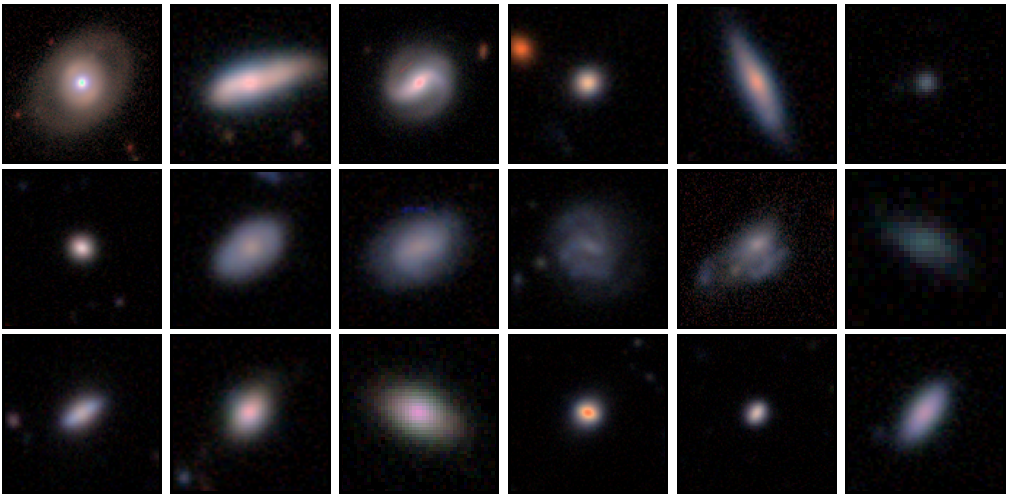
Joan Najita (NOIRLab)
8 February 2025
One of the remarkable things we’ve learned about galaxies over the past few decades is that they often come with a special surprise in the middle — a huge black hole. Weighing in at more than a million times the mass of the Sun, these “supermassive black holes” are found at the centers of almost all galaxies similar to or more massive than the Milky Way. Why do galaxies have these black holes? And how did they get there? Do much lower mass galaxies also have central black holes? These questions have motivated the search for black holes in low-mass “dwarf galaxies,” systems that may provide vital clues regarding the origin of black holes in the Universe.
A recent paper, led by Ragadeepika Pucha (U. Utah), takes a big step in this direction. Analyzing DESI spectra of dwarf galaxies, the researchers identified candidate black holes that are actively accreting matter from their surroundings. The feeding process produces a characteristic spectrum of bright atomic emission lines that the researchers used to identify these systems as Active Galactic Nuclei (AGN). The study detected AGN signatures in over 2000 dwarf galaxies, more than tripling the number of known dwarf galaxies with candidate black holes. The detections, which extend to lower galaxy masses and higher redshifts (i.e., further back in time) than previously probed, suggest that black holes may commonly exist even in these very low-mass galaxies.
We sat down with Raga to learn more about this remarkable result.

Questions for Raga:
Q: Why was it important to increase the census of dwarf AGN? Was this difficult before DESI?
A: Dwarf galaxies are the most abundant galaxies in the Universe, and understanding their growth is crucial for piecing together the puzzle of galaxy formation and evolution. Because their lower mass (and therefore lower gravity) makes it more challenging for them to hang on to their gas, the energy output from the AGN, which can eject gas from a galaxy, can potentially have a major impact on a dwarf galaxy’s ability to continue to form stars. What happens exactly remains an open question. To explore this complex interplay between dwarf galaxy evolution and black hole evolution, we first need to establish a robust statistical sample of dwarf AGN candidates.
Historically, this has been a real challenge. Because low-mass galaxies are faint, it has been difficult to measure the spectra of a large sample and identify dwarf AGN candidates. But DESI is changing the landscape with its ability to measure spectra of many objects simultaneously. The early DESI data included spectroscopy of nearly 115,000 dwarf galaxies, from which we uncovered the largest sample of dwarf AGN candidates to date. Part of the success is the result of the smaller fiber size of DESI, which makes it easier to focus on the light from the central region of the galaxy, where the AGN is, and ignore the starlight from the rest galaxy. As a result, we were able to identify fainter dwarf AGN candidates than in previous studies.
Q: It looks like you find that dwarf galaxies also commonly host black holes. Do these results tell us anything about the origin of supermassive black holes in general?
A: A major question about supermassive black holes is how they formed. What mass did the black hole start out with? What was its “seed” mass? Because lower mass galaxies are likely to harbor lower mass black holes, they may provide a bridge between stellar mass black holes (< 100 solar masses) — which are familiar to us from X-ray binaries and LIGO gravitational wave sources — and supermassive black holes at the centers of large galaxies. These “intermediate mass black holes”, while elusive to date, are theorized to be the “seeds” of supermassive black holes and the relics of the first black holes formed in the Universe.
With DESI, we’ve found the lowest mass black holes in galaxies to date. Since black holes can only grow over time and cannot disintegrate into smaller ones, these findings suggest that the black holes we are observing may be analogs of the primordial black holes that formed in the early Universe, i.e., the “seed black holes” of supermassive black holes. A very small number of our sources may even be primordial black holes, having persisted through the ages with little to no evolution.
Q: What do you find most interesting about the results?
A: We find that nearly 2% of dwarf galaxies host active black holes, a significant increase compared to the ~0.5% reported in earlier studies. This is an exciting result, as it suggests that we have been missing a substantial number of undiscovered black holes. It opens the possibility that even more black holes are concealed within these low-mass galaxies.
The ability to detect an active black hole depends on several factors, including the black hole’s mass, the availability of gas in its vicinity, the accretion rate, and the sensitivity of the instruments used to detect the emission from the resulting AGN. As a result, for a given galaxy mass, the black holes we observe will tend to be either the most massive or those with the highest accretion rates, depending on the specific telescope and instrument used.
Our findings show that the fraction of galaxies hosting actively accreting black holes increases with galaxy mass, reaching nearly 100% for the most massive galaxies. This suggests that when a massive galaxy has an active black hole, it is readily detected by DESI. In contrast, in lower-mass galaxies, the emission from ongoing star formation can mask or dilute the AGN signal, making it harder to detect their faint AGN. This does not imply that low-mass, star-forming galaxies do not host black holes, but rather that we are currently identifying all the actively accreting black holes that are detectable with our instruments.
Q: What drew your interest to this topic?
A: When I began my PhD, my primary goal was to delve into the field of galaxy formation and evolution. I was particularly drawn to dwarf galaxies, as they are the most common kind of galaxy in the universe, yet they remain poorly understood. What are their histories? Do they follow the same evolutionary path as more massive galaxies? Or does the energy released by their active black holes (if they have one) play a significant role in shaping their growth?
By sheer coincidence, my advisors, Stephanie Juneau and Arjun Dey, encouraged me to join the DESI collaboration, which turned out to be the perfect opportunity to dive deeper into this research. They were incredibly supportive of the idea to use DESI data to search for dwarf AGN candidates as a first step in understanding the evolution of dwarf galaxies in the universe.
An unexpected bonus was realizing that this project also ties into one of the most fundamental and exciting questions in present day astronomy: the formation of supermassive black hole seeds. The chance to simultaneously explore the evolution of dwarf galaxies and the origins of supermassive black holes has been deeply motivating. The interconnection between these two lines of inquiry, and the potential to advance our understanding on both fronts, has been a truly rewarding aspect of my research journey.
Q: What’s next for you?
A: With the largest sample of dwarf AGN and IMBH candidates now at our disposal, we are poised to tackle some of the most pressing questions in the study of supermassive black hole seed formation and the co-evolution of dwarf galaxies and their central black holes. My upcoming projects will focus on examining the relative effects of AGN versus star-formation feedback in dwarf galaxies, exploring the energetics related to these feedback mechanisms, and characterizing the population of dwarf AGN candidates identified through multi-wavelength and multi-diagnostic approaches.
My DESI collaborators and I also plan to investigate the demographics of these black holes, employing modeling techniques to study whether all galaxies have black holes (or what fraction do), as well as the black hole mass function in the universe. We will expand these analyses to include DESI Year 3 data, which will further enhance the scale and scope of our research.